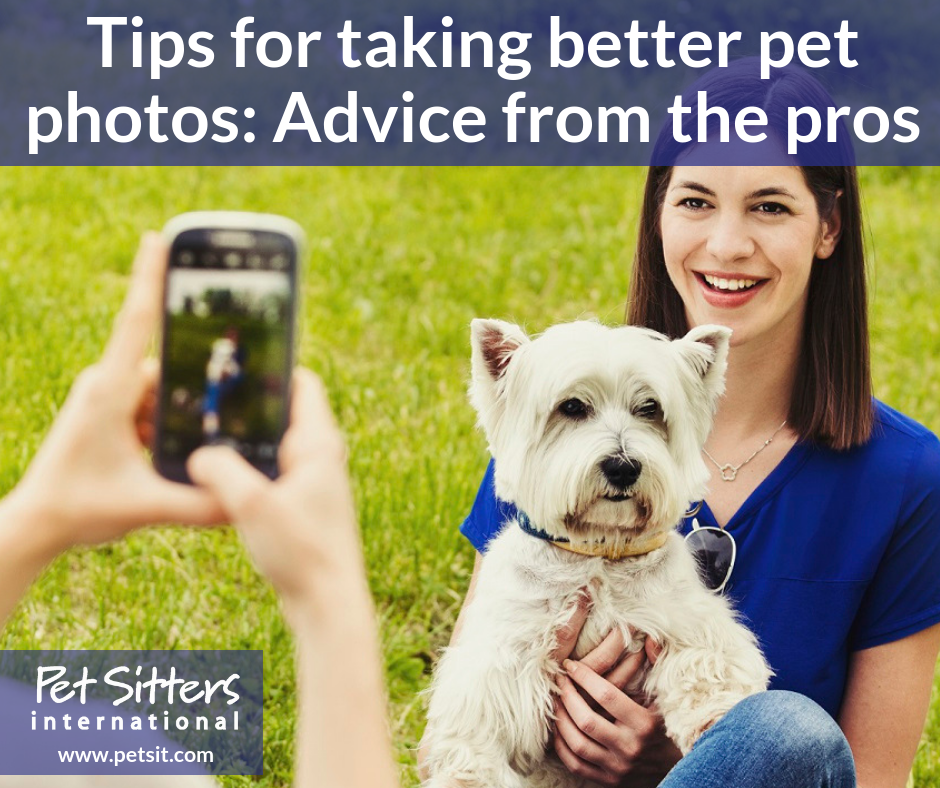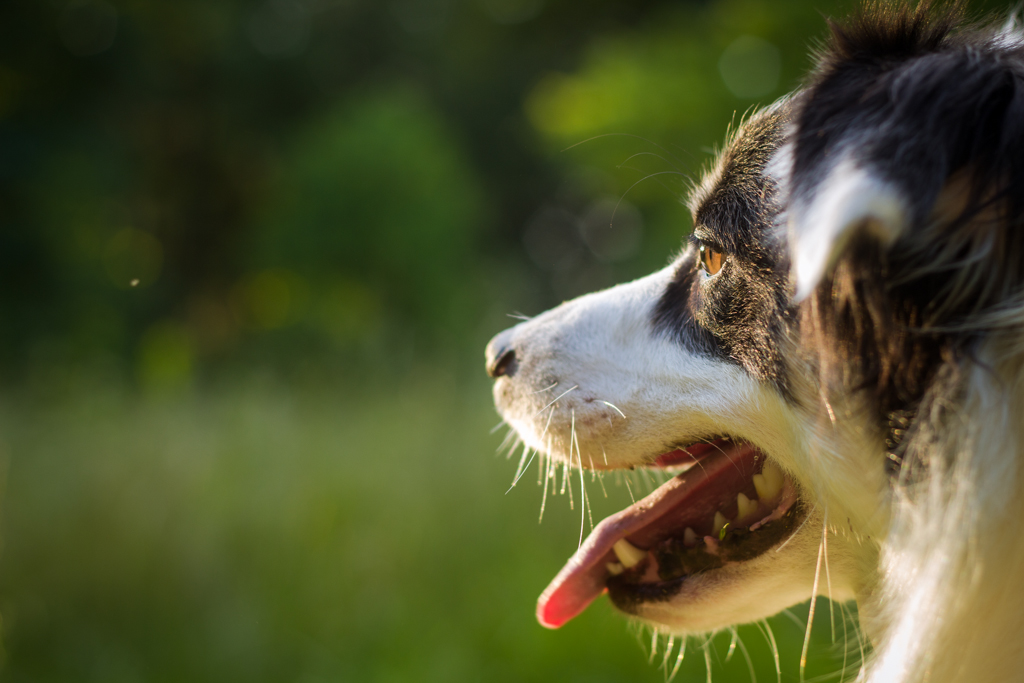Tips for taking better pet photos: Advice from the pros
By Rachel Sokol
As a professional pet sitter, you love your job and all the animals in your care. Since you already treat them like your own, chances are you photograph them like they’re your own! It’s nice to remember the animals in your care, and thanks to the power of pictures you can cherish the memories.
Aside from just snapping some pics to text over to your human clients, you may want to gift them with a beautiful photo of the pet you both adore. You may also want to take some sharp, one-of-a-kind photos of your pet clients for your own marketing materials—which is why sharpening your photography skills can’t hurt, right?
We spoke with the pros about the ins-and-outs of pet photography. Here are their tips for taking awesome pet photos to add to your personal and professional portfolio.

Don’t stress—patience is key
“Patience is the secret to my success as a pet photographer,” says Brooke Jacobs of New York, NY. “If a pet is nervous, the best thing to do is figure out how to make them comfortable and happy.”
Maybe slow down on ”getting the shot,” says Jacobs, and sit with them and love on them so they feel happy and comfortable. “Treats help, too!”
Because Jacobs spends time with the animals, she gets to ”know” them and makes sure they’re having tons of fun during the shoot so their personality shines. “Most dogs love the attention and treats and all the focus being 100 percent on them. Cats usually do too, you just might have to work for their attention a little more!”
When it comes to dogs, Jonathan Rose, a UK-based photographer for pet accessories company Aurora Pets, says any dog will be at their happiest when they are comfortable, with their owners, and eating. “If you can combine these things, you are sure to get a great photo to really capture the personality of your pet.”
San Francisco, CA-based photographer Sarah Sloboda says pet sitters “know all the tricks” for getting the pets to sit still/be where they want them to, “so that's a great advantage!” By the time you’re ready to shoot some photos of the animal, chances are you know each other fairly well.
Adds Sloboda: “My first rule of thumb with pets is, let them be themselves! If they are spunky, let them be in motion in the shot. If they are still and thoughtful, absolutely get a close-up of their face.”
Don’t try to go against their natural tendencies, she stresses. “It just creates frustration.”
Focus on ‘the middle’ with traditional cameras
By ”day,” Christina Borders of North Carolina is a puppy trainer. By night, her side gig is animal photography. “Whether shooting with a point and shoot or a DSLR—a camera with an interchangeable lens, like a Canon Rebel—be sure your middle focus point is always with your pet’s eyes,” she advises. “Using a telephoto lens, a ZOOM lens, or a fast aperture (deals with the amount of light that enters the camera to expose the image on the sensor) can help to achieve the ‘blurry’ background many people want.”
Embrace your camera phone
When they first came out, camera phones took “meh” pictures. But not anymore! You can get some amazing pet pictures with your phone. “The trick,” says Sloboda, “will probably be learning how to take a smartphone photo with one hand. It takes a bit of practice to hold it steady with one hand, but then your other hand is free to hold out a treat or toy.”
Jacobs calls basic digital cameras “incredible.”
“Just because one doesn’t have lighting or a big expensive camera doesn’t mean they can’t take top quality photographs of their pet,” she says. “Pick a time of day when there is good lighting in the home or shoot outside and organize an ideal spot. Having good light and a spot that is free of distractions is key so you just have to focus on getting that ‘perfect’ moment with the pet.”
Adds Jacobs: “Working with treats and perhaps having an extra person on hand to help keep the pet at the ideal spot is also very helpful.”
Go for the candid shot
Natural, not forced, can make for the best pictures. “Candid photos are often much easier to get than posed or staged pictures,” says Borders. “They also reveal more of your pet’s personality, showcasing them in a native environment or engaged in a favorite activity.”
Adds Rose: “Sometimes, the simplest interactions can be the best photos: a dog running through his favorite park, licking his owner's nose, a cuddle…just make sure the dog is comfortable and happy and it’s a recipe for a great photo.”
Focus on framing
According to Rose, when you’re ready to shoot a pet pic, think about how to frame your subject and which orientation works best with the surroundings and composition to take the best photo. For example, if your pet is sitting up on a plain background, a vertical frame might be best. “Or, if the animal is laying down, then horizontal might work best and vice-versa if you wish to get an interesting piece of background in to lead your eye to your subject.”
Post-production, Rose doesn't really use filters and instead opts to edit the highlights and shadows of the picture. “There are lots of phone apps that will allow you to do this easily and free, such as ‘Afterlight 2’ and ‘PicsArt.’”
Try ‘fast-moving’ photos
Want to snap a dog on the run? On your iPhone, for quick-moving subjects, “you’ll need a fast shutter speed to avoid blur,” explains Borders. “Putting your camera or phone on sports mode is very helpful.”
She adds: “Even the portrait mode on your iPhone is a great tool for taking nice shots worthy of framing.”
Aim for the ‘Golden Hours’
When it comes to the time of day, early morning and late afternoon/early evening produce the most flattering and beautiful light, says Borders. “Photographers call these the golden hours due to the soft warm light. Try to avoid shooting in the middle of the day because the light is very harsh and can over expose your photos to the point they can’t be rescued in editing software.”

Photo taken by Christina Borders
Consider using a GoPro
“Personally, I love GoPro shots of animals, where the camera is mounted on something they like or with a treat under it to get their attention and they go straight for it,” says Sloboda. “The super wide angle of a GoPro combined with the close-up of the animal makes it pretty comical! Shooting a video and extrapolating a still works well for this.”
Opt for props—sparingly
Adding props to pics can result in a fun and quirky image—but consider using them sparingly. “I’m all for props if it doesn’t compete with the pet but adds to the shot,” says Jacobs. “Who doesn’t like a dog or cat in a bowtie! Or surrounded by holiday décor?”
Be creative to get the shot
If you’re aiming to get an animal’s attention at a certain, specific time, basically do what you need to do.
“If the animal is hyper, you can bribe them with treats or try and stop them in their tracks by making a strange sound to have them stop and look at where that noise is coming from—and maybe even cock their head!” says Jacobs. “I have a lot of noises I make, from heavy breathing to barks to ape sounds and clucks. It sounds crazy, but it works when you find that sound that interests them.”
‘Practice’ by donating your time
Photographing all these great animals may put you in a good mood—so why not “pay it forward”? “Donate as much time as possible to organizations and shelters by photographing their pets,” advises Jacobs. “It helps get the word out and is great practice. It’s a way to get an endless supply of models while doing a good deed.”

Rachel Sokol is a Manhattan-based writer, editor and animal lover. She's been published on Univsion.com, Reader's Digest online, Redbook, CountryLiving.com, LiveHappy.com and more.







Comments
Dog Savant
Annie Harms